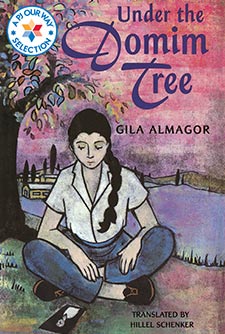The Storyteller's Beads
Sahay and Rahel are all alone, traveling through strange and dangerous territory in Ethiopia, trying to reach Jerusalem. They are both brave, but is bravery enough to survive?
Average Rating
( hint: Login to leave a review! )
64 Reviews
Leave Review
What the Book is About
Jewish Content & Values
Positive Role Models
Content Advisory
Talk it Over!
More for You
What the Book is About
This is a beautifully written story about two Ethiopian girls from very different backgrounds: Rahel is blind and from the Beta-Israel (Jewish) community; Sahay is an orphan and from the Kemant (Christian) community. The girls overcome their prejudices and learn to love and trust each other during their dangerous and difficult journey across Ethiopia and the Sudan.
Jewish Content & Values
- Aliyah (literally “going up”; refers to the immigration of Jews from the Diaspora to Israel): As a basic tenet of Ethiopian Jewish belief, Rahel’s community always dreamed of Aliyah. Thoughts of Jerusalem comfort and sustain Rahel through her dangerous journey.
- Respect for elders: Jewish Ethiopian villagers relied on the guidance of wise elders who made important decisions for the community. Because Rahel’s grandmother is one such woman, she is known as a “baaltet”.
- Biblical perspective of the Beta Israel: Rahel’s wise grandmother taught her many biblical stories, using a string of amber beads to help her remember. Later, Rahel remembered the stories and repeated them during her journey to give people strength. Since these stories are told in the Ethiopian narrative, they are somewhat different from traditional bible stories, but are similar enough to recognize.
Positive Role Models
- Rahel’s grandmother is the matriarch of the family. When Rahel became blind from an illness, her grandmother patiently taught her the skills she needed to become self-sufficient and to be able to contribute to the family. When Rahel leaves her home, her grandmother gives her courage by teaching her the stories of her heritage, while instilling in her a deep pride of her Jewish identity.
- Rahel is a true role model for young girls. She doesn’t allow a serious disability get in her way and her strong commitment to her Jewish heritage gives her strength and inspires others.
- Sahay is a loyal friend who overcomes the prejudices of her upbringing. She is tactful enough to cease calling Rahel’s people “falashas” (literally “strangers” in the Amharic language; a derogatory term used to describe Ethiopian Jews) and begins calling them by their true name, the Beta Israel.
Content Advisory
The following could be emotionally difficult:
War, famine, and drought are rampant in Ethiopia and the journey to the Sudan is very dangerous. Sahay is the only survivor when the“Red Terror” group kills her parents and brother. Rahel’s people are called “falashas” and there is discussion of violent religious persecution against Ethiopian Jews. At one point in the journey, “shiftas” (highwaymen) attack and begin shooting while Sahay and Rahel hide in a ravine. And once the two girls arrive at the refugee camp, “Umm Rekuba”, there are some troubling descriptions of disease, privation, and even death. Although these topics are quite serious, the story is narrated from the perspective of two young girls, and there is a happy ending.Talk it Over!
While begging for food, Sahay is bullied by Amharic children. They call her buda (devil) and throw stones at her because she is Kemant. Her uncle tells her "whenever misfortune comes, everyone looks for someone to blame." What do you think he means by that?
More for You
The Beta Israel community in Israel today is mostly comprised of immigrants and descendants of dramatic secret airlifts that were orchestrated by the Israeli government in the 1980’s and 90’s. These airlifts succeeded in rescuing thousands of Ethiopian Jews from starvation and disease.
Although they no longer suffer from the consequences of state sanctioned and social persecution, adjustment to Israeli society has been slow for many immigrants, mostly due to their lack of formal education and due to discrimination. Today, young Beta Israel men and women have more opportunities than their parents did to fully integrate into Israeli society thanks to their service alongside other Israelis in the Israeli Defense Forces and National Service. Some famous young Ethiopian Israelis include the member of Knesset (Israeli Parliament) Pnina Tamano-Shata and the first Ethiopian winner of Miss Israel 2013, Yitiyish Titi Aynaw.
What the Book is About
What the Book is About
This is a beautifully written story about two Ethiopian girls from very different backgrounds: Rahel is blind and from the Beta-Israel (Jewish) community; Sahay is an orphan and from the Kemant (Christian) community. The girls overcome their prejudices and learn to love and trust each other during their dangerous and difficult journey across Ethiopia and the Sudan.
Jewish Content & Values
Jewish Content & Values
- Aliyah (literally “going up”; refers to the immigration of Jews from the Diaspora to Israel): As a basic tenet of Ethiopian Jewish belief, Rahel’s community always dreamed of Aliyah. Thoughts of Jerusalem comfort and sustain Rahel through her dangerous journey.
- Respect for elders: Jewish Ethiopian villagers relied on the guidance of wise elders who made important decisions for the community. Because Rahel’s grandmother is one such woman, she is known as a “baaltet”.
- Biblical perspective of the Beta Israel: Rahel’s wise grandmother taught her many biblical stories, using a string of amber beads to help her remember. Later, Rahel remembered the stories and repeated them during her journey to give people strength. Since these stories are told in the Ethiopian narrative, they are somewhat different from traditional bible stories, but are similar enough to recognize.
Positive Role Models
Positive Role Models
- Rahel’s grandmother is the matriarch of the family. When Rahel became blind from an illness, her grandmother patiently taught her the skills she needed to become self-sufficient and to be able to contribute to the family. When Rahel leaves her home, her grandmother gives her courage by teaching her the stories of her heritage, while instilling in her a deep pride of her Jewish identity.
- Rahel is a true role model for young girls. She doesn’t allow a serious disability get in her way and her strong commitment to her Jewish heritage gives her strength and inspires others.
- Sahay is a loyal friend who overcomes the prejudices of her upbringing. She is tactful enough to cease calling Rahel’s people “falashas” (literally “strangers” in the Amharic language; a derogatory term used to describe Ethiopian Jews) and begins calling them by their true name, the Beta Israel.
Content Advisory
Content Advisory
The following could be emotionally difficult:
War, famine, and drought are rampant in Ethiopia and the journey to the Sudan is very dangerous. Sahay is the only survivor when the“Red Terror” group kills her parents and brother. Rahel’s people are called “falashas” and there is discussion of violent religious persecution against Ethiopian Jews. At one point in the journey, “shiftas” (highwaymen) attack and begin shooting while Sahay and Rahel hide in a ravine. And once the two girls arrive at the refugee camp, “Umm Rekuba”, there are some troubling descriptions of disease, privation, and even death. Although these topics are quite serious, the story is narrated from the perspective of two young girls, and there is a happy ending.
Talk it Over!
Talk it Over!
While begging for food, Sahay is bullied by Amharic children. They call her buda (devil) and throw stones at her because she is Kemant. Her uncle tells her "whenever misfortune comes, everyone looks for someone to blame." What do you think he means by that?
More for You
More for You
The Beta Israel community in Israel today is mostly comprised of immigrants and descendants of dramatic secret airlifts that were orchestrated by the Israeli government in the 1980’s and 90’s. These airlifts succeeded in rescuing thousands of Ethiopian Jews from starvation and disease.
Although they no longer suffer from the consequences of state sanctioned and social persecution, adjustment to Israeli society has been slow for many immigrants, mostly due to their lack of formal education and due to discrimination. Today, young Beta Israel men and women have more opportunities than their parents did to fully integrate into Israeli society thanks to their service alongside other Israelis in the Israeli Defense Forces and National Service. Some famous young Ethiopian Israelis include the member of Knesset (Israeli Parliament) Pnina Tamano-Shata and the first Ethiopian winner of Miss Israel 2013, Yitiyish Titi Aynaw.




